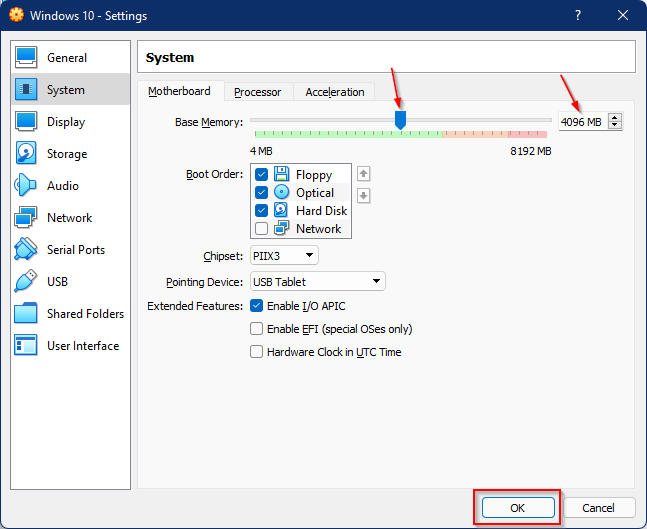

- #HOW MUCH MEMORY TO RUN WINDOWS 10 VIRTUALBOX HOW TO#
- #HOW MUCH MEMORY TO RUN WINDOWS 10 VIRTUALBOX INSTALL#
- #HOW MUCH MEMORY TO RUN WINDOWS 10 VIRTUALBOX UPDATE#
- #HOW MUCH MEMORY TO RUN WINDOWS 10 VIRTUALBOX PC#
- #HOW MUCH MEMORY TO RUN WINDOWS 10 VIRTUALBOX PROFESSIONAL#
The Second Edition included Internet Explorer 5.0, and Internet Connection Sharing. Installing Windows 98 with ACPI support is done by entering setup /p j at the DOS Command Prompt, otherwise it requires a registry change after installation. ACPI provided an open standard that brought about transferring power management across from being dependent on the computer’s BIOS to the operating system itself. Desktop Themes and utilities offered with Microsoft Plus! for Windows 95 were also added, USB support improved, and the introduction of DVD.ĪCPI (Advanced Configuration & Power Interface) had also been introduced, though is typically disabled by default upon installation. shell enhancements such as the Quick Launch toolbar) were now integrated.
#HOW MUCH MEMORY TO RUN WINDOWS 10 VIRTUALBOX UPDATE#
Originally available separately or as part of Windows 95 OSR 2.5, Internet Explorer 4.0 and the Windows Desktop Update (e.g. The RTM release brought together several bits and pieces that were made available for Windows 95 over time. To understand the differences between the two, I’ll briefly go over the changes. Unless it’s out of curiosity, there’s not really a compelling reason to not go with SE. Windows 98 saw two releases over its lifetime, the original RTM in June 1998, followed by the Second Edition (SE) in May 1999. Despite all the mention of gaming, VirtualBox is better suited for applications.
#HOW MUCH MEMORY TO RUN WINDOWS 10 VIRTUALBOX PC#
Personally I built a Pentium III 800 MHz PC for Windows 98 gaming, and it’s brilliant for this. Also if the intent is gaming where DirectX and 3D acceleration is needed, I’d be more inclined to use PCem to emulate hardware from the era. Unfortunately VirtualBox once again provides limited support for Windows 98, so the Guest Additions isn’t going to be of use.

We suggest that your physical machine has at least: If you assign low amount of RAM to virtual machine, Ubuntu might not even boot or you may experience weird problems! Ubuntu Linux is not exactly a lightweight operating system (OS) to run under virtual environment and you will need a decent processor (CPU) and at least 4 GB of RAM memory to run it properly. This goes beyond the scope of this article, as its main purpose is focused on home users. no need for host operating system) in order to maximize hardware utilization, VM performance and compatibility.
#HOW MUCH MEMORY TO RUN WINDOWS 10 VIRTUALBOX PROFESSIONAL#
Professional server environments use hypervisors that run directly on the hardware (e.g.

virtual machine inside another virtual machine inside a hypervisor ( our tutorial about installing VMware Player on Ubuntu Linux was actually done on a Windows computer!). Nested virtualizations are also possible e.g.
#HOW MUCH MEMORY TO RUN WINDOWS 10 VIRTUALBOX INSTALL#
There are many different hypervisors and software products (Microsoft Hyper-V, VMware Workstation, Oracle VirtualBox, Parallels Desktop are some of the big names in this area to name just a few – see full list here) and possibilities to install virtual machine on your existing physical computer. Virtual Machine is a virtualized hardware (software defined) running your favorite operating system (OS) on a similar or different physical computer hardware and/or operating system.Host Machine is a physical computer that runs Hypervisor and Virtual Machines.Hypervisor is a software application used to manage your virtual machine (VM) appliance and communicate between a host computer / operating system or directly with physical hardware.
#HOW MUCH MEMORY TO RUN WINDOWS 10 VIRTUALBOX HOW TO#
VirtualBox – How To Create Ubuntu Virtual Machine on Windows 10 Host Basic Virtualization Terminology


 0 kommentar(er)
0 kommentar(er)
